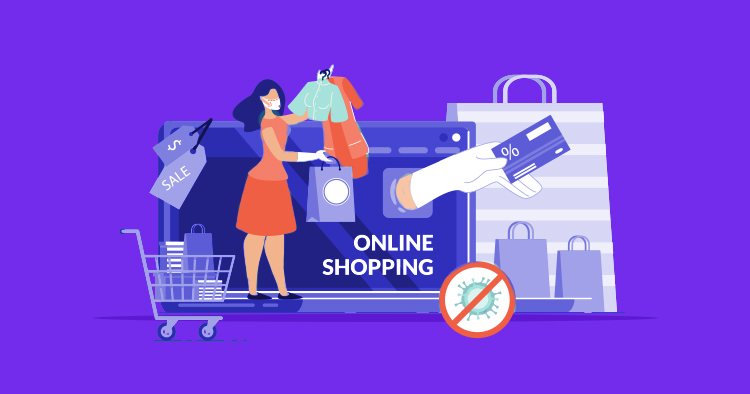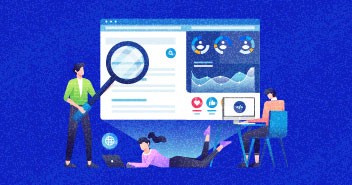
Ever since COVID-19, there’s been a notable change in the Revenue Strategiesbehavior of people visiting ecommerce stores. The change seems to stem from the quarantine lifestyle and the buying behavior of online customers.
In this blog, I’ll look into how to promote your online store by adopting some short-term revenue strategies that’ll help you reach out to your ideal customers. To understand this we need to first understand what influence the market has on your business and your ideal customer.
It’s important to understand why certain ecommerce businesses have been on a rise pre-quarantine are now experiencing a sharp drop in sales. The reason here stems from the recent changes in lifestyle that move buyers’ attention to essential items and household appliances.
This shift can be a great opportunity for online store owners to increase their ecommerce revenue and boost their business growth by providing the right products to the right people! First, let’s understand the changes in the online buying behavior of potential customers.
How COVID-19 is Affecting Businesses
Circumstances of staying at home due to the threat of COVID-19 has influenced the market of household items and decreases the demand for travel accessories.
The infographic below illustrates the increase in the sale of disposable gloves, cough and flu medicines, and kitchen appliances that help make cooking simple and easy. On the other hand, products relevant to traveling, outdoor activities, and social gatherings have seen a sharp decline.

According to Red Points, 360 Survey Digital Commerce, Business Insider, and MediaRadar Ad spend for ecommerce sites doubled from $4.8 million to $9.6 million in less than a month. This increase in ad spend is because of recent government restrictions on traveling and outdoor activities that require interacting with a group of people. After adopting the stay-at-home lifestyle people resorted to online purchasing.
Ecommerce store owners change their inventory to better suit products for home, resulting in sales skyrocketing. This shows the potential of the ecommerce business when the right products are available.
Now you’re probably wondering what revenue strategies will pace up the sales of your online store as most people are holding onto money at times like these. The next few sections of this blog explain how to stop leakage of money, introducing new finances into your business, and adopting a strategy to cater to current demand.
Revenue Strategies to Improve Cash Flows & Promote Your Business
Here’s what you need to do to improve the cash flows of your online store. After that, you’ll start promoting your business to give it the visibility it needs to reach the recommended audience.
1. Decrease Shipping Costs
A large portion of your business margins is taken away by shipping costs. Here are a few recommendations to cut back additional costs:
a. Try Fulfilling Orders Manually
You can use affordable and almost free courier services in the United States; (USPS, DHL Express, and UPS) and Canada (Canada Post). You can use these services except for when shipping products that have legal requirements such as frozen food, fragile items, etc.
b. Set Up Local Shipping
For customers that are closer to your business, adding a local delivery option can decrease the price of products. Since local delivery options are low cost (or even free), if the option is available, grab it.
2. Build a Pre-order Strategy
It’s a good idea to build some hype through marketing and promotional strategies to pull online traffic on your website. What you can do as part of the pre-order strategy is to float a survey to find out the kind of products the target audience prefer to see on your online store.
Alternatively, you can also float a similar survey to find out the products/services merchants have trouble selling and work a deal with them to help them sell these products as part of bundles and grand deals.
3. Promote Gift Cards
Gift cards are one of the popular revenue strategies that give retailers a way to increase cash available for the business and (in most cases) encourage customers to spend more at your online store. This is favorable for businesses with smaller profit margins, as gift cards assist in keeping customers engaged with your online store.

To incentivize customers, you’ll want to give out discount gift cards or Tremendous gift cards, or maybe collaborate with complementary businesses to form co-marketing opportunities that will assist you in acquiring new customers. Finally, to scale back the danger of human contact, you can initiate a digital gift card program and promote it through social media and email promoting campaigns.
4. Give Discounts on Underperforming Stock
Retailers that sell non-essential products will likely see a decline in demand. Hence, businesses in this category should cut down on production and wait for slow-moving inventory to decrease. For the next six months, retailers’ main revenue strategy should be to increase the turn rate of the stock.

Use reporting and inventory management apps to perform an ABC inventory analysis that prioritizes products by the value they create businesses.
- A-grade items are the most valuable
- B-grade items are the “middle of the road” products
- C-grade items are the low-value products that contribute value through hundreds of small transactions.
You can reduce costs by decreasing C-grade products or consider giving heavy discounts bundles when selling these products. At first, this might be counterintuitive to businesses, however, it will provide the cash flow, makes space for stock that has more contribution value and moves faster.
5. Extend Suppliers Payment Deadline
In order to ease up the cash situation, you should consider revenue strategies that help in reducing expenses first. You can do this by extending payment deadlines of your suppliers. In order to initiate these deals, it’s a best practice that the retailer and supplier come to a consensus at the earliest and establish an agreement.
6. Pause Standing orders with Suppliers
Pausing standing orders decreases the time stock stays in the inventory. This revenue strategy is helpful as it slows the rate of production and reduces the volume of stock that can’t be moved easily.
7. Managing Staff Costs
One of the toughest decisions for businesses pertains to staff retention as revenue decreases (a direct impact of the Coronavirus). Businesses can ask staff to work remotely from home or take unpaid leave in order to retain them when there isn’t enough work for them to do.
8. Monitor Government Relief Packages
As a last resort, you can take a loan that governments around the world are rolling out. These measures help support small businesses that are badly hit by COVID-19 pandemic and require working capital to remain solvent.
A number of government organizations mention that they’ll be giving tax concessions to companies that implement a zero layoff policy. Government bodies work differently around the globe so you’ll have to look out for the ones that apply to you.
Here are three resources to help you stay up-to-date with COVID-19 government relief funds:
Seeking Alternative Financing Options
Once you’ve exhausted all efforts in injecting capital into your business and stopped leakages, it’s time to look for a few alternative financing options. Three major options to get funding from are nongovernment lending organizations, short-term banking loans, and private equity.
1. Short Term Banking Loan
Most commercial banks have a dedicated team that caters to lending to SMBs. You can check with your local commercial banks for small business support lending packages that your business might qualify for. Currently, many governments are also offering incentivized lending products through commercial banks for SMBs affected by the prevalent COVID-19 situation.

The good thing about banking loans is that they usually carry lower interest rates compared to non-banking loans and private equity investments, allowing you to reduce costs and better manage your cash flows. However, the qualification criteria are usually more stringent and the approval process can take longer. In addition, banks usually require some form of collateral to secure the loans along with a good credit history.
2. Non-Government Organizations
Many microfinance banking/non-banking financial institutions and private debt investment institutions have a special interest in SMBs and their revenue growth. These organizations usually offer unsecured loans without the need for any collateral with less stringent qualification criteria.

That being said, the benefit of ease of access is set off by the fact that loans offered by these institutions usually carry higher interest rates and can compromise business independence. The creditor has a considerable say in business decisions, as a way of compensating for the risk they’ve taken in providing an unsecured loan.
3. Private Equity
Private equity is not limited to equity firms and commercial/investment banks. A private equity investor could be one of your well-off friends or family members, willing to offer financial assistance in your time of need.
All things being considered this should ideally be your funding option of last resort An equity holder is effectively a part-owner of the business and in this capacity (should they choose to) they can severely compromise your independence in how you run your business and might even become the final approving authority on major business decisions. Furthermore, equity investors insist upon a certain mandatory return on their investment, failing which they might decide to pull out. This can add further pressure on your business to perform exceptionally well to meet their expectations, which might be unrealistic given the already tough economic conditions.
Optimize the Sales Funnel to Fit Your Ecommerce Budget (Short-Term Strategy)
Assuming that you already know how a sales funnel works, I’m now going to now elaborate on a few promotional and revenue strategies that you can adopt to quickly improve your ecommerce revenue.
Let’s talk about adapting your ecommerce budget to better suit the needs of the changing consumer behavior.
Though these times are tougher due to the quarantine lifestyle, know that some people may have more disposable income as they aren’t spending money as much. Lifestyle expenditures such as restaurants, sports events, and outdoor hobbies are not permitted by most government health bodies, hence, they’d be more likely to pay for products on your ecommerce store.
Changing the Perspective of your Audience
Pre-quarantine, several products (and product lines) were marketed as if they cater to the cardinal needs of the audience. Phrases as Death By Chocolate, Death Wish Coffee, and Toxic Sour Candy were very popular. You’re going to have to shift away from this language if you wish to attract the targeted audience to your store during COVID-19.

As part of a revenue strategy, you can also look into promoting products that are likely to be used indoors during the COVID-19 lockdown. Examples of such products are laptop screen protectors, wall decoration items, family entertainment board games, and just about anything that can have a positive impact on the cooped-up people.

You should also consider connecting with new merchants that have products that can better fit the demands of a household dealing with a lockdown. Consider sourcing products bundled with Netflix subscription packages as most family units would want to watch a movie while being locked up.
Products in the category of Do It Yourself (DIY), health & beauty, home gym equipment, fitness gear, and home & gardening are areas that you should consider as the new inventory items.
With the addition of these products, you’re likely going to see an influx of customers. This is where you need to take action and offer these products on a subscription basis. For instance, you could sell appointments with famous fitness coaches for a monthly/bi-weekly routine. This way, your customer is likely to come back to your ecommerce store and purchase more subscriptions.

Show Empathy
Now that customers are frequenting your ecommerce store, you should make it a point to return a part of the earnings back. It’s unethical to focus solely on profits and ask customers to share stories for your financial gain.
Make it about them, by asking the customers to share stories of your brand through social media with their friends to get further discounts. More people know about your products and brand, with the impression of how satisfied your customers (their friends), you’re on the right path to recovery.
This is a great time to expand your digital presence to other social media channels.

Consider the number of people in lockdown, and how the use of social media has increased. If you grew your social media presence you’ll get more potential customers to browse your online store.
You should also consider getting your product listed on platforms like Cred, Paytm, Phonepe Switch, LBB, StepSetGo to increase traffic on your website which then leading to more sales
End Note
It’s important to understand that the COVID-19 quarantine is a temporary phase but its effects on the lifestyle may last for years. With travel bans, public gathering restrictions, and a work-from-home lifestyle – this scenario can be an opportunity for you to help people by providing them with a medium to purchase essentials without exposing them to this contagious pandemic.
I explored avenues of reviving your business from the slump while providing products that are higher in demand. I discussed revenue strategies and their multiple facets of injecting capital into your online store, and the direction your online store needs to face to avoid roadblocks.
If you feel we missed out on anything we’d love to know about your two-cents regarding this matter. Comment below, and let’s get in touch 🙂
Sajjad Shahid
Sajjad is an Ecommerce Community Manager at Cloudways. He loves helping out Ecommerce store owners, merchants and marketers in establishing their businesses and startups. Sajjad enjoys playing table tennis and cricket over the weekend.


